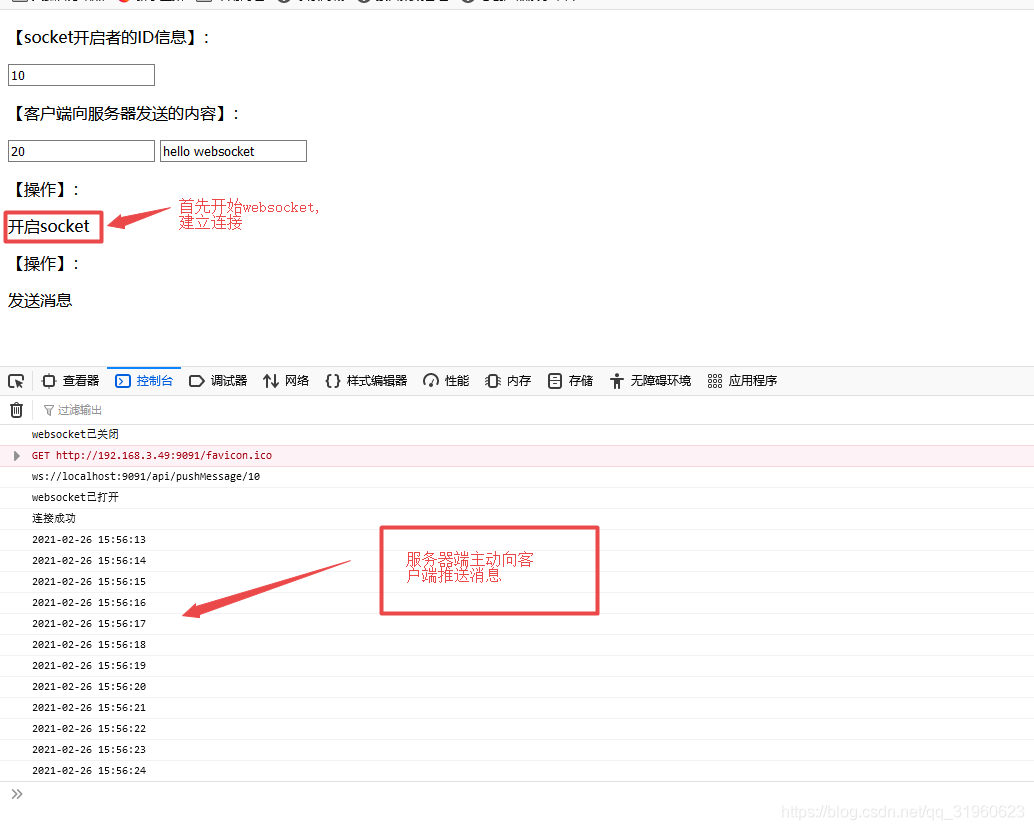目录
WebSocket协议是基于TCP的一种新的网络协议。它实现了浏览器与服务器全双工(full-duplex)通信——允许服务器主动发送信息给客户端。websocket 协议是在 http 协议上的一种补充协议,是 html5 的新特性,是一种持久化的协议。
基于Tcp三次握手?
第一次握手:
客户主动(active open)去connect服务器,并且发送SYN,假设序列号为J,服务器是被动打开(passive open)
第二次握手:
服务器在收到SYN后,它会发送一个SYN以及一个ACK(应答)给客户, ACK的序列号是J+1,表示是给SYN J的应答,新发送的SYN K序列号是K。
第三次握手:
客户在收到新SYN K、ACK J+1后,也回应ACK K+1以表示收到了,然后两边就可以开始发送数据了
案例
添加pom依赖
<!--webSocket-->
<dependency>
<groupId>org.springframework.boot</groupId>
<artifactId>spring-boot-starter-websocket</artifactId>
</dependency>
websocket配置
/**
* 开启WebSocket支持
*
*/
@Configuration
public class WebSocketConfig {
@Bean
public ServerEndpointExporter serverEndpointExporter() {
return new ServerEndpointExporter();
}
}
WebSocketServer
下面是websocket的重点
1.@ServerEndpoint("/api/pushMessage/{userId}") 前端通过此 URI 和后端交互,建立连接
2.@Component 不用说将此类交给 spring 管理
3.@OnOpen websocket 建立连接的注解,前端触发上面 URI 时会进入此注解标注的方法
4.@OnMessage 收到前端传来的消息后执行的方法
5.@OnClose 顾名思义关闭连接,销毁 session
60因为WebSocket是类似客户端服务端的形式(采用ws协议),那么这里的WebSocketServer其实就相当于一个ws协议的Controller
7.新建一个ConcurrentHashMap webSocketMap 用于接收当前userId的WebSocket,方便IM之间对userId进行推送消息
?
核心代码如下
?
/**
* websocket的处理类。
* 作用相当于HTTP请求
* 中的controller
*/
@Component
@Slf4j
@ServerEndpoint("/api/pushMessage/{userId}")
public class WebSocketServer {
/**静态变量,用来记录当前在线连接数。应该把它设计成线程安全的。*/
private static int onlineCount = 0;
/**concurrent包的线程安全Set,用来存放每个客户端对应的WebSocket对象。*/
private static ConcurrentHashMap<String,WebSocketServer> webSocketMap = new ConcurrentHashMap<>();
/**与某个客户端的连接会话,需要通过它来给客户端发送数据*/
private Session session;
/**接收userId*/
private String userId = "";
/**
* 连接建立成
* 功调用的方法
*/
@OnOpen
public void onOpen(Session session,@PathParam("userId") String userId) {
this.session = session;
this.userId=userId;
if(webSocketMap.containsKey(userId)){
webSocketMap.remove(userId);
//加入set中
webSocketMap.put(userId,this);
}else{
//加入set中
webSocketMap.put(userId,this);
//在线数加1
addOnlineCount();
}
log.info("用户连接:"+userId+",当前在线人数为:" + getOnlineCount());
sendMessage("连接成功");
}
/**
* 连接关闭
* 调用的方法
*/
@OnClose
public void onClose() {
if(webSocketMap.containsKey(userId)){
webSocketMap.remove(userId);
//从set中删除
subOnlineCount();
}
log.info("用户退出:"+userId+",当前在线人数为:" + getOnlineCount());
}
/**
* 收到客户端消
* 息后调用的方法
* @param message
* 客户端发送过来的消息
**/
@OnMessage
public void onMessage(String message, Session session) {
log.info("用户消息:"+userId+",报文:"+message);
//可以群发消息
//消息保存到数据库、redis
if(StringUtils.isNotBlank(message)){
try {
//解析发送的报文
JSONObject jsonObject = JSON.parseObject(message);
//追加发送人(防止串改)
jsonObject.put("fromUserId",this.userId);
String toUserId=jsonObject.getString("toUserId");
//传送给对应toUserId用户的websocket
if(StringUtils.isNotBlank(toUserId)&&webSocketMap.containsKey(toUserId)){
webSocketMap.get(toUserId).sendMessage(message);
}else{
//否则不在这个服务器上,发送到mysql或者redis
log.error("请求的userId:"+toUserId+"不在该服务器上");
}
}catch (Exception e){
e.printStackTrace();
}
}
}
/**
* @param session
* @param error
*/
@OnError
public void onError(Session session, Throwable error) {
log.error("用户错误:"+this.userId+",原因:"+error.getMessage());
error.printStackTrace();
}
/**
* 实现服务
* 器主动推送
*/
public void sendMessage(String message) {
try {
this.session.getBasicRemote().sendText(message);
} catch (IOException e) {
e.printStackTrace();
}
}
/**
*发送自定
*义消息
**/
public static void sendInfo(String message, String userId) {
log.info("发送消息到:"+userId+",报文:"+message);
if(StringUtils.isNotBlank(userId) && webSocketMap.containsKey(userId)){
webSocketMap.get(userId).sendMessage(message);
}else{
log.error("用户"+userId+",不在线!");
}
}
/**
* 获得此时的
* 在线人数
* @return
*/
public static synchronized int getOnlineCount() {
return onlineCount;
}
/**
* 在线人
* 数加1
*/
public static synchronized void addOnlineCount() {
WebSocketServer.onlineCount++;
}
/**
* 在线人
* 数减1
*/
public static synchronized void subOnlineCount() {
WebSocketServer.onlineCount--;
}
}
消息推送
至于推送新信息,可以在自己的Controller写个方法调用WebSocketServer.sendInfo()即可。
程序中使用定任务不停的向客户端发送消息。
@Controller
@RequestMapping("/api/test")
@Api(description = "服务器向客户端推送消息接口", tags = "Test")
public class TestController {
@Autowired
private TestServiceImpl testServiceImpl;
/**
* 启动页面
* @return
*/
@GetMapping("/start")
public String start(){
return "index";
}
@PostMapping("/pushToWeb")
@ApiOperation(value = "服务器端向客户端推送消息", notes = "服务器端向客户端推送消息")
public ResponseBean<?> pushToWeb(@RequestBody @ApiParam(value = "回收人编码和医院编码", required = true) CodesInfo info){
testServiceImpl.printTime();
return new ResponseBean<>(200, "success", "123456");
}
}
@Service
@EnableScheduling
public class TestServiceImpl {
//打印时间
@Scheduled(fixedRate=1000) //1000毫秒执行一次
public void printTime(){
SimpleDateFormat dateFormat = new SimpleDateFormat("HH:mm:ss");
String date = dateFormat.format(new Date());
WebSocketServer.sendInfo(date,"10");
System.out.println(date);
}
}
建立websocket连接
<!DOCTYPE html>
<html>
<head>
<meta charset="utf-8">
<title>websocket通讯</title>
</head>
<script src="https://cdn.bootcss.com/jquery/3.3.1/jquery.js"></script>
<script>
let socket;
function openSocket() {
const socketUrl = "ws://localhost:9091/api/pushMessage/" + $("#userId").val();
console.log(socketUrl);
if(socket!=null){
socket.close();
socket=null;
}
socket = new WebSocket(socketUrl);
//打开事件
socket.onopen = function() {
console.log("websocket已打开");
};
//获得消息事件
socket.onmessage = function(msg) {
console.log(msg.data);
//发现消息进入,开始处理前端触发逻辑
};
//关闭事件
socket.onclose = function() {
console.log("websocket已关闭");
};
//发生了错误事件
socket.onerror = function() {
console.log("websocket发生了错误");
}
}
function sendMessage() {
socket.send('{"toUserId":"'+$("#toUserId").val()+'","contentText":"'+$("#contentText").val()+'"}');
console.log('{"toUserId":"'+$("#toUserId").val()+'","contentText":"'+$("#contentText").val()+'"}');
}
</script>
<body>
<p>【socket开启者的ID信息】:<div><input id="userId" name="userId" type="text" value="10"></div>
<p>【客户端向服务器发送的内容】:<div><input id="toUserId" name="toUserId" type="text" value="20">
<input id="contentText" name="contentText" type="text" value="hello websocket"></div>
<p>【操作】:<div><a onclick="openSocket()">开启socket</a></div>
<p>【操作】:<div><a onclick="sendMessage()">发送消息</a></div>
</body>
</html>
运行结果
服务器端向客户端发送消息

?
?
?